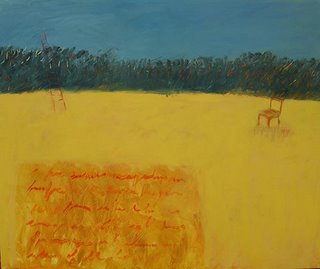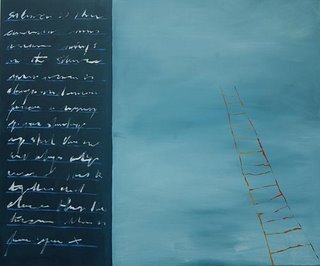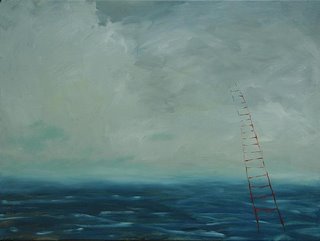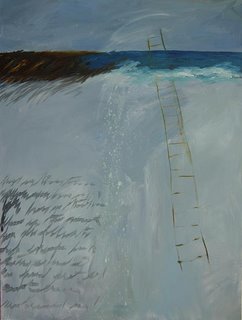Bernadette Burns (DIT) Triptych Project





Text to accompany Bernadette Burns work
A Limitless Wandering of Thought
And he dreamed, and behold a ladder set up on the earth, and the top of it reached to heaven…
Standing midst the landscapes of ‘Jacob’s Ladder’, the overall impression they convey is calm and contemplative. Broad, apparently simple planes are juxtaposed to render foreground and a distant horizon. Writing, traced in paint, hovers within and above the layered landscapes. Many feature water and a distant island. Some look across a warm stretch of sand or yellowed grass, others look toward or through an open door.
The work of imaginative construction required by the simple landscape schema in works such as Colour Field draws you in; an expanse of bright yellow sand sweeps toward a narrow strip of sea with a hazily distant island beneath a darkening sky. A strong brown stripe running along the right edge of the painting, punctuated by red writing, seems likely to be a fence post in the immediate foreground, perhaps marking an entrance to the beach. The simple beauty of the scene is inviting. And yet my advance into the picture is refused. The simplicity of this imagined landscape is only momentary. The brown post of the foreground runs ambiguously to the sea, disrupting the fragile coherence of the scene. The shifting yellow plane of sand refuses to recede, becoming instead an upright plane with five blue lines scraped on it or through it. I am returned to the surface of the painting, an expanse of colour disrupted only by the texture of the paint.
The scripts, whose rhythm so often reflects that of the painting on which it sits – like ripples on the water of Crossing Over or the scratched grass of Travelling Light – promise to lead to the heart of the work. Narratives are inscribed, perhaps fragmentary and ambiguous, but central to many of the paintings. And yet the promise of these words is withheld; they cannot be deciphered.
Exact meaning and an exact topography are thus beyond reach, and a sustained imaginative engagement is invited instead. In works such as Upon the Water and Open Door II, a strong motif within Burns work - the doorway - suggests a kind of presence that is evident throughout ‘Jacob’s Ladder’. The doorway brings two spaces together, a beyond is brought close. This juxtaposition of physical spaces marks a particular kind of presence within the landscape, a presence to the immediate surroundings and an awareness that also wanders beyond its boundaries, whether remembering or imagining.
With the introduction of the ladder motif, this figuring of an active connection between discrete planes of thinking and being, or modes or presence within the landscape, is retraced. The ladder is not about escape or escapism. In paintings such as Between Here and There the immersion in landscape is too particular, emphatic and solid, and the ladder does not lead to another place. Instead, the ladder disrupts the landscape schema to actively figure a second possibility within that space, dreaming. An open horizon of possibility encountered within a particular place.
More whimsically, this space for dreaming within the landscape, anchored in the structures of a particular place but not simply of that place, is marked by disruptions such as the floating turquoise square of Crossing Over. Suspended midst blue water and an ochre shore, this ambiguous space is written into the surrounding waters and yet is a world of its own.
The particular places of these paintings are Sherkin Island off the coast of West Cork, Tipperary and Crete. The sandy shores and surprisingly high skies of Sherkin have long been a refuge and source of inspiration for Burns. An abandoned reservoir near her home in Tipperary is a growing presence in her work and recent trips to Crete are directly reflected in a number of small paintings and indirectly in the ladder motif emerging in the work. (The Jacob’s Ladder of the exhibition title and the paintings was inspired by Greek icons.)
Water – and its invitation to imagine freely - is common to all three places. Where they differ is in season and mood. Sherkin and Crete are rendered through the high skies and distant horizon of summer. The reservoir is a winter space. In Flow the skeleton of a tree is shrouded in a dark green that seems to remember dense foliage, or the rich humus underfoot of long-since fallen leaves. A sense of the horizon drawn near is given by the distinct band of light and dark lines running across the top of the painting. In the uncertain light, a rush of watery blue casts a spray of unravelling script. This is the misty blurring of winter, of drops that sit heavily on and fall wetly from twigs and sodden surfaces. And the space for imagining and remembering is differently configured. Here it is the seeping of one space into the next – the misty uncertainty of the boundary between distinct spaces and planes – that enables the limitless wandering of thought.
The paintings of ‘Jacob’s Ladder’ are specific – they capture a time and a place. And they are wilfully ambiguous, inscribing something of the remembering and imagining that may irrupt in or infuse a particular time and a place. What the paintings reveal and invite is dream-laden reflection in a landscape.
Siun Hanrahan

0 Comments:
Post a Comment
Subscribe to Post Comments [Atom]
<< Home